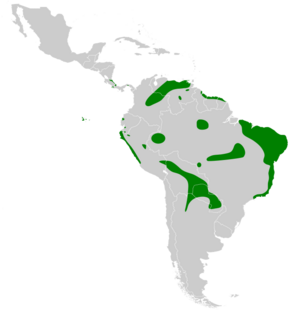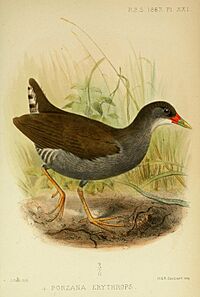Paint-billed crake facts for kids
Quick facts for kids Paint-billed crake |
|
|---|---|
 |
|
| Conservation status | |
| Scientific classification | |
| Genus: |
Mustelirallus
|
| Species: |
erythrops
|
 |
|
| Range (note: distribution in Central America and the Galapagos is missing.) | |
| Synonyms | |
|
Mustelirallus erythrops |
|
The paint-billed crake (Mustelirallus erythrops) is a small bird that belongs to the Rallidae family. This family includes rails, crakes, and coots. You can find this bird in Costa Rica, Panama, and most countries in South America. It also lives on the Galápagos Islands.
Contents
About Its Name
Scientists often study how different animals are related. The paint-billed crake was first placed in the Porzana group. Later, it moved to the Neocrex group with the Colombian crake. Some scientists even thought these two birds were the same species!
Today, many experts agree that the paint-billed crake belongs in the Mustelirallus group. This article uses that name. The paint-billed crake has two main types, called subspecies: N. e. erythrops and N. e. olivascens.
What Does It Look Like?
The paint-billed crake is about 18 to 20 centimeters (7 to 8 inches) long. It weighs around 40 to 70 grams (1.4 to 2.5 ounces). Its name comes from its colorful bill, which is red and yellow. It also has bright red legs. Both male and female birds look very similar.
The N. e. erythrops subspecies has a brown head, neck, and back. Its throat is white, and its face, chest, and throat are gray. Its sides and belly have black and white stripes. The N. e. olivascens subspecies looks similar but is a bit darker. It also has less white on its throat.
Where Does It Live?
The N. e. erythrops subspecies lives along the coasts of Ecuador and Peru. It also lives on the Galápagos Islands. The N. e. olivascens subspecies is found in many places. In Central America, it lives in Costa Rica and Panama.
In South America, you can find it in Argentina, Bolivia, Brazil, Colombia, French Guiana, Guyana, Paraguay, Peru, Suriname, and Venezuela. Sometimes, it flies far from its usual home. It has been seen in Trinidad and even in Texas and Virginia in the U.S..
This bird lives in many different places. It likes very wet areas like marshes and reedbeds. It also lives in wet and dry pastures, rice fields, and bushy areas. On the Galápagos Islands, it lives in humid forests. In South America, it often prefers swamps and grassy areas with thick bushes. It can live from sea level up to almost 3,400 meters (11,000 feet) high.
Behavior
How It Moves Around
Scientists are not sure if the paint-billed crake moves around regularly. However, it has been seen far from its normal range many times. This means it might travel a lot, or some groups might migrate. It does not respond to recorded bird calls.
What Does It Eat?
We don't know much about what the paint-billed crake eats. It is known to eat small creatures without backbones, like millipedes and beetles. It also eats seeds. It searches for food in the soil, in fallen leaves, and in shallow water. At dawn and dusk, it has been seen eating in open areas near thick plants.
Reproduction and Life Cycle
The paint-billed crake's breeding time changes a lot depending on where it lives. It builds a bowl-shaped nest using green grass. The nest is usually on or near the ground, hidden in the grass.
A female bird lays three to seven eggs. The eggs are creamy buff with large reddish spots near the wider end. The eggs hatch after at least 23 to 25 days.
What Does It Sound Like?
The paint-billed crake's song is a long series of quick, yelping notes. It can make up to 36 of these "kjek" sounds, getting faster as it sings. Its other calls sound like "frog-like, guttural, buzzy, single notes," a "mellow soft purring," and a "sharp 'twack'."
Status
The IUCN (International Union for Conservation of Nature) says the paint-billed crake is a species of "Least Concern." This means it is not currently in danger of disappearing. It lives in a very large area, but we don't know how many of these birds there are or if their numbers are changing.
It is a very shy bird and hard to see. Because of this, it's difficult to know exactly how many there are or where they all live. More research is needed to understand its numbers, where it lives, and how it moves around.




